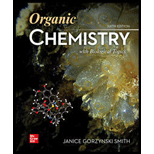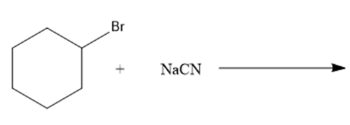
(a)
Interpretation: The nucleophile, leaving group and product formed needs to be identify for the given substitution reaction.

Concept Introduction: In a nucleophilic substitution reaction, the electron rich nucleophile attacks on the electrophilic center of an electrophile (electron deficient) to form nucleophile substituted product. Here, nucleophile can be neutral or have a negative charge. The substitution of nucleophile on the electrophile causes leaving group to leave the electrophile.
(b)
Interpretation: The nucleophile, leaving group and product formed needs to be identify for the given substitution reaction.

Concept Introduction: In a nucleophilic substitution reaction, the electron rich nucleophile attacks on the electrophilic center of an electrophile (electron deficient) to form nucleophile substituted product. Here, nucleophile can be neutral or have a negative charge. The substitution of nucleophile on the electrophile causes leaving group to leave the electrophile.
(c)
Interpretation: The nucleophile, leaving group and product formed needs to be identify for the given substitution reaction.

Concept Introduction: In a nucleophilic substitution reaction, the electron rich nucleophile attacks on the electrophilic center of an electrophile (electron deficient) to form nucleophile substituted product. Here, nucleophile can be neutral or have a negative charge. The substitution of nucleophile on the electrophile causes leaving group to leave the electrophile.
(d)
Interpretation: The nucleophile, leaving group and product formed needs to be identify for the given substitution reaction.

Concept Introduction: In a nucleophilic substitution reaction, the electron rich nucleophile attacks on the electrophilic center of an electrophile (electron deficient) to form nucleophile substituted product. Here, nucleophile can be neutral or have a negative charge. The substitution of nucleophile on the electrophile causes leaving group to leave the electrophile.
Want to see the full answer?
Check out a sample textbook solution
Chapter 7 Solutions
ORGANIC CHEMISTRY W/BIOLOGICAL TOPICS
- Draw a Lewis structure for each of the following species. Again, assign charges where appropriate. a. H-H¯ b. CH3-CH3 c. CH3+CH3 d. CH3 CH3 e. CH3NH3+CH3NH3 f. CH30-CH3O¯ g. CH2CH2 - h. HC2-(HCC) HC2 (HCC) i. H202×(HOOH) H₂O₂ (HOOH) Nortonarrow_forwardIs molecule 6 an enantiomer?arrow_forwardShow work. Don't give Ai generated solutionarrow_forward
- Check the box under each structure in the table that is an enantiomer of the molecule shown below. If none of them are, check the none of the above box under the table. Molecule 1 Molecule 2 Molecule 3 ----||| Molecule 4 Molecule 5 Molecule 6 none of the above mm..arrow_forwardShow work. don't give Ai generated solutionarrow_forwardCheck the box under each structure in the table that is an enantiomer of the molecule shown below. If none of them are, check the none of the above box under the table. Molecule 1 Molecule 2 Molecule 3 ----||| Molecule 4 Molecule 5 Molecule 6 none of the above mm..arrow_forward
- Use the vapor-liquid equilibrium data at 1.0 atm. for methanol-water (Table 2-8 ) for the following: If the methanol vapor mole fraction is 0.600, what is the methanol liquid mole fraction? Is there an azeotrope in the methanol-water system at a pressure of 1.0 atmospheres? If water liquid mole fraction is 0.350, what is the water vapor mole fraction? What are the K values of methanol and of water at a methanol mole fraction in the liquid of 0.200? What is the relative volatility αM-W at a methanol mole fraction in the liquid of 0.200?arrow_forwardCheck the box under each structure in the table that is an enantiomer of the molecule shown below. If none of them are, check the none of the above box under the table. || |II***** Molecule 1 | Molecule 4 none of the above Molecule 2 Molecule 3 Х mm... C ---||| *** Molecule 5 Molecule 6arrow_forwardis SiBr4 Silicon (IV) tetra Bromine? is KClO2 potassium dihypochlorite ?arrow_forward
- "יוון HO" Br CI Check the box under each structure in the table that is an enantiomer of the molecule shown below. If none of them are, check the none of the above box under the table. Molecule 1 Molecule 2 Molecule 3 Br Br Br HO OH H CI OH ✓ Molecule 4 Molecule 5 Molecule 6 CI Br יייון H Br OH OH CI Br ☐ none of the above × Garrow_forwardUS2 Would this be Uranium (II) diSulfide?arrow_forwardnomenclature for PU(SO4)3arrow_forward
 Organic Chemistry: A Guided InquiryChemistryISBN:9780618974122Author:Andrei StraumanisPublisher:Cengage Learning
Organic Chemistry: A Guided InquiryChemistryISBN:9780618974122Author:Andrei StraumanisPublisher:Cengage Learning
